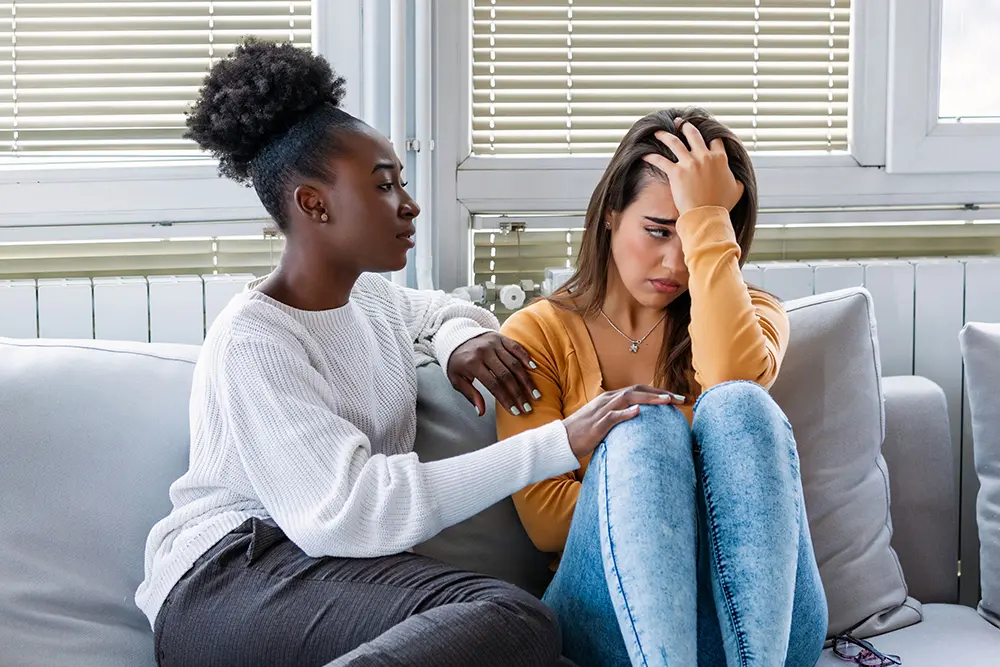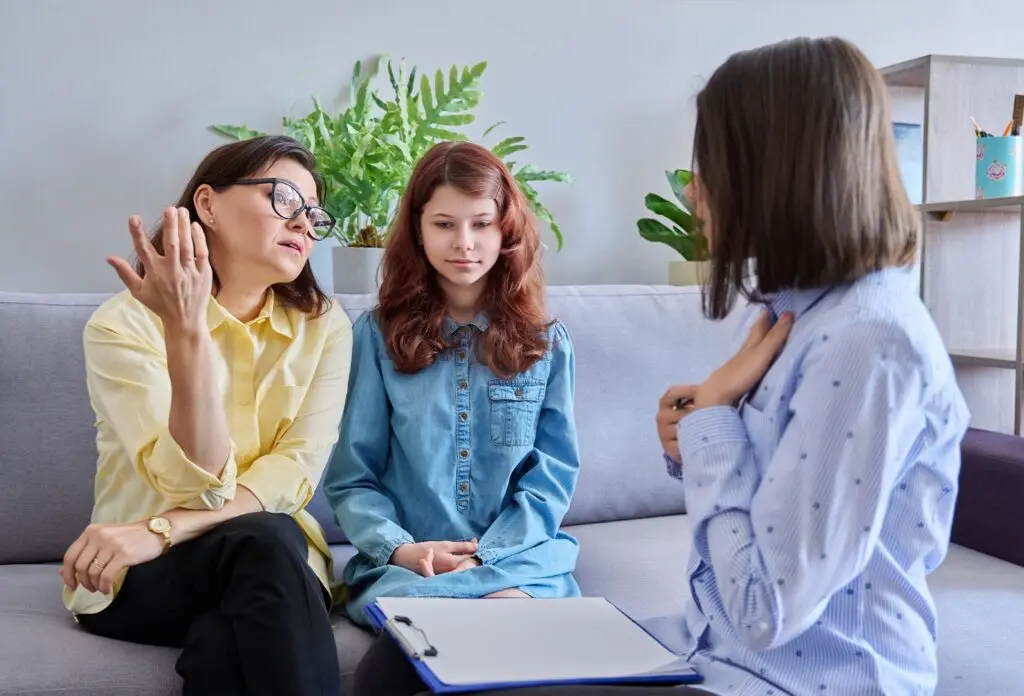
Anxiety is a common experience during the teenage years, but not all anxiety is the same. For some adolescents, worry and fear can become overwhelming and start to interfere with daily life. This is when anxiety moves beyond typical stress and becomes a mental health concern.
Many families search for answers when anxiety symptoms start to affect school, friendships, or family routines. Understanding the different types of anxiety and how they present in teens is an important first step in finding appropriate help.
Treatment for teenage anxiety disorders is most effective when it’s tailored to the unique needs of teenagers. This guide provides evidence-based information on what adolescent anxiety is, how it differs from normal stress, and what treatment programs are available.
Take Our Anxiety in Teens Parent Quiz
If you’re concerned your child could have anxiety, take our test for parents to understand your child’s behavior better.
Understanding Adolescent Anxiety
Adolescent anxiety refers to persistent feelings of worry, nervousness, or fear that are intense enough to interfere with a teenager’s daily life. Unlike normal stress, which might arise before a big exam or social event and then fade, anxiety disorders are ongoing and can impact many areas of functioning.
Anxiety disorders are among the most common mental health conditions in adolescents. These disorders include generalized anxiety disorder (worrying about many things), social anxiety disorder (fear of social situations), panic disorder (sudden, intense fear), separation anxiety disorder (fear of being apart from caregivers), and specific phobias (extreme fear of certain objects or situations).
Treatment for teenage anxiety addresses symptoms that can look different from those seen in adults. Adolescents might show anxiety through irritability, trouble concentrating, declining grades, avoiding friends or activities, or physical symptoms like headaches or stomachaches. They may also have difficulty describing their emotional experiences, sometimes expressing distress through behavior rather than words.
Signs That Anxiety Has Become a Problem
Treatment for childhood anxiety disorders recognizes that anxiety affects more than just mood. It can interfere with sleep, appetite, school attendance, and relationships. Recognizing when anxiety moves beyond everyday worries helps families know when to seek professional support.
Key indicators include:
- Persistent worry: Excessive anxiety that lasts for weeks or months, not just during stressful events
- Daily interference: Symptoms that affect school performance, friendships, or family relationships
- Physical complaints: Frequent headaches, stomachaches, or other symptoms without medical cause
- Avoidance patterns: Skipping school, avoiding social situations, or refusing to participate in activities
- Sleep disruption: Trouble falling asleep, staying asleep, or frequent nightmares
Why Early Detection Matters

Untreated anxiety in adolescents often continues over time and can become more serious. These ongoing symptoms can make it harder to manage everyday activities and can increase the risk of other mental health concerns.
When anxiety is not identified and addressed early, it can lead to problems in school, such as lower grades or frequent absences. Some adolescents may avoid friends or stop taking part in activities, leading to social isolation. There is also a higher chance of developing depression, which may require teen depression treatment, or turning to substances like alcohol or drugs to cope with difficult feelings, which can make substance abuse treatment necessary.
Recognizing anxiety early allows for more effective support and treatment, which can prevent these challenges from getting worse. Early intervention is linked to better outcomes for both mental health and daily life.
Common Causes and Risk Factors
Anxiety in adolescents develops from a combination of genetic, environmental, psychological, and social factors. There is rarely a single cause; instead, several influences often interact to affect how and when anxiety appears. Having a first-degree relative, such as a parent or sibling, with an anxiety disorder increases the likelihood that a teen will experience anxiety as well.
Environmental Stressors That Contribute to Teen Anxiety
Certain life circumstances and daily challenges are known to trigger or worsen anxiety symptoms in adolescents:
- Academic pressure: Expectations to perform well in school, standardized testing, and homework demands
- Social media exposure: Time spent online that leads to comparison, cyberbullying, or fear of missing out
- Peer relationship challenges: Difficulty making or keeping friends, peer rejection, or social exclusion
- Family conflict: Arguments, parental separation, or instability at home
- Major life changes: Moving, changing schools, or losing a loved one
- Traumatic experiences: Exposure to abuse, neglect, bullying in adolescence, or witnessing violence
Certain personality traits also make some adolescents more likely to experience severe anxiety. These include behavioral inhibition (tendency to withdraw from unfamiliar situations), high sensitivity (feeling emotions more intensely), and perfectionism (setting very high standards and being critical of mistakes).
Evidence-Based Therapies for Treating Anxiety in Teens
Psychological therapies are the primary approach for treating teenage anxiety disorders. Extensive research shows that these therapies are effective for most teens experiencing anxiety disorders. Mental health professionals use structured methods to help teens learn new ways to think about and manage their anxiety.
Cognitive Behavioral Therapy
Cognitive Behavioral Therapy (CBT) is a structured, short-term treatment focused on identifying and changing unhelpful thoughts and behaviors. In CBT, teens learn to recognize patterns in their thinking that increase anxiety, such as expecting the worst or overestimating danger. Therapists guide teens in challenging these patterns, called cognitive distortions, and replacing them with more balanced thoughts.
CBT also involves behavioral experiments, where teens practice facing situations that cause anxiety in small, manageable steps. This process helps reduce avoidance and increases confidence. CBT is usually delivered in weekly sessions over 12-20 weeks and can be done individually, in groups, or with family involvement.
Dialectical Behavior Therapy
Dialectical Behavior Therapy (DBT) is another therapy used to treat anxiety in adolescents, especially when a teen struggles with intense emotions or self-harming behaviors. DBT teaches skills for managing strong feelings, improving relationships, and coping with stress without making the situation worse.
DBT sessions include individual therapy and skills training groups. Skills training focuses on four main areas: mindfulness (staying present), distress tolerance (handling tough situations), emotion regulation (understanding and changing emotions), and interpersonal effectiveness (interacting with others). DBT may be considered when CBT alone does not address all the difficulties a teen is experiencing.
Exposure and Response Prevention
Exposure and Response Prevention (ERP) helps teens gradually face situations or objects that trigger anxiety. The therapist and teen work together to create a list of feared situations, ranking them from least to most distressing. Teens then practice approaching these situations step by step, starting with the least distressing.
For example, a teen with social anxiety disorder might begin by answering a question in a small group, then later give a presentation to the class. A teen worried about academic performance may practice turning in assignments without excessive checking. When separation from parents is the main concern, the teen may spend increasing amounts of time away from home.
ERP is based on the concept of habituation, which means that anxiety naturally decreases when a person stays in a feared situation without avoiding or escaping. Over time, the brain learns that the situation is not as dangerous as it seemed, and the symptoms of anxiety disorder decrease.
Medication Options and Considerations

Medication is considered in teen anxiety treatment when symptoms are moderate to severe, when anxiety causes significant problems with daily life, or when therapy alone does not lead to enough improvement. Some teens may have difficulty participating in therapy because their anxiety is too intense, and medication can help lower symptoms to a manageable level.
SSRIs and SNRIs
Selective serotonin reuptake inhibitors (SSRIs) and serotonin-norepinephrine reuptake inhibitors (SNRIs) are two main types of medications used in the treatment of anxiety in teenagers. These medications increase levels of certain neurotransmitters—serotonin and sometimes norepinephrine—in the brain, which can help regulate mood and reduce anxiety.
The SSRIs fluoxetine, sertraline, and fluvoxamine are FDA-approved for use in adolescents with certain anxiety disorders. SNRIs such as duloxetine are also sometimes used, with duloxetine approved for generalized anxiety disorder in children aged 7 and older.
Side Effects and Monitoring
Common side effects of these medications include an increase in severe symptoms related to anxiety during the first week or two, changes in sleep patterns, headaches, stomachaches, nausea, and diarrhea. These effects often decrease over time as the body adjusts. Some teens experience appetite changes or weight fluctuations.
More serious side effects are rare but important to recognize:
- Suicidal thoughts: All antidepressants carry a black box warning about increased risk of suicidal thoughts in children and adolescents.
- Behavioral activation: Some teens may experience increased agitation, restlessness, or irritability.
- Serotonin syndrome: A rare but serious condition that can occur when serotonin levels become too high
Close monitoring by mental health providers and families is especially important during the first few weeks after starting medication or changing the dose. Regular follow-up appointments help track response and adjust the plan if needed.
How Combined Treatment Improves Outcomes of Anxiety Disorders
Current research indicates that using both therapy and medication together for adolescent anxiety disorders can lead to better results compared to using either approach alone. The Child/Adolescent Anxiety Multimodal Study (CAMS) found that 80.7% of participants who received both cognitive behavior therapy and medication responded positively to treatment. By comparison, 59.7% responded to CBT alone, and 54.9% responded to medication alone.
Combined treatment is often used when anxiety is severe, when symptoms do not improve enough with therapy or medication alone, or when anxiety causes significant problems with daily tasks, relationships, or school attendance. Some adolescents benefit from starting with one approach and then adding the other if progress is limited.
Family Involvement and Support Strategies to Improve Mental Health
Family involvement is linked to better outcomes in treatment for anxiety disorders. When parents and caregivers participate in the process through family therapy and other supportive avenues, teens often experience greater improvement in mental health and sustain gains.
Communication That Helps
Clear and supportive communication helps teens talk about their anxiety disorder. Validation means acknowledging the teen’s feelings without dismissing or minimizing them. Avoiding constant reassurance is important because it can make anxiety worse over time. Encouraging brave behavior involves recognizing when a teen is trying something difficult, even if they feel anxious.
Helpful response example:
Teen: “I’m scared to go to the party. What if nobody talks to me?”
Parent: “It sounds like you’re really nervous about being left out. That’s hard. I’m proud of you for considering going, even though it makes you anxious.”
Unhelpful response example:
Teen: “I’m scared to go to the party. What if nobody talks to me?”
Parent: “Don’t worry, you’ll be fine. There’s nothing to be afraid of. Just go and have fun.”
Setting Appropriate Boundaries
Balancing support with gentle challenges helps teens learn to cope with anxiety. Too much accommodation, such as allowing teens to avoid all anxiety-provoking situations, can reinforce anxious patterns. Setting appropriate boundaries involves agreeing on which accommodations are helpful and which ones may hold the teen back.
For example, a teen anxious about attending school might stay in the guidance counselor’s office for the first period, but after that, join their class. This provides initial support while still encouraging participation.
FAQs About Anxiety Treatment for Children and Adolescents
What is the success rate for the treatment of anxiety disorders in teenagers?
Evidence-based treatments for adolescent anxiety, such as cognitive behavioral therapy and medication, have success rates between 60% and 80%. The highest effectiveness is seen when therapy and medication are used together when appropriate.
How long does adolescent anxiety treatment typically take?
Most evidence-based therapy programs for adolescent anxiety involve 12 to 20 weekly sessions. Some adolescents may participate in treatment for a longer period if symptoms are more severe or complex.
Will my teenager need to take anxiety medication forever?
Most adolescents do not take anxiety medication for life. The usual duration varies, but medication is often gradually reduced after 6 to 12 months of symptom improvement, depending on individual progress.
How can I find specialized anxiety treatment for my teenager in Massachusetts?
Specialized treatment for anxiety disorders can be accessed through referrals from pediatricians, school counselors, or by contacting adolescent mental health centers such as the Massachusetts Center for Adolescent Wellness.
What should I do if my teenager refuses treatment?
Refusal of treatment is common. Parents can validate their teen’s concerns, provide information about available treatment options, consider starting with less intimidating approaches, and discuss engagement strategies with professionals.
Building Long-Term Wellness for Your Teen

Recovery from adolescent anxiety involves more than just reducing symptoms; it’s about building skills and support systems that last. Skills taught in therapy, such as recognizing thinking patterns, using relaxation techniques, and communicating feelings, help teens manage stress and challenges throughout their lives.
Ongoing support remains important after formal treatment ends. Regular check-ins with counselors, therapists, or support groups can help address new concerns, monitor for symptoms, and reinforce healthy habits. Staying connected with supportive adults and peers also helps maintain progress.
The Massachusetts Center for Adolescent Wellness provides a continuum of care that addresses different stages of recovery. This includes intensive treatment programs, step-down outpatient care, aftercare planning, and alumni support opportunities. These levels of support help adolescents transition from structured treatment to greater independence while maintaining access to resources if challenges arise. Contact us today for more information.




